![\begin{figure}
\par\includegraphics[width=7.8cm,clip]{4654f080.eps} \end{figure}](/articles/aa/full/2006/37/aa4654-05/Timg104.gif) |
Figure 1: The advection timescales as defined in Eq. (1) versus post-bounce time. The lines are smoothed over time intervals of 5 ms. |
| Open with DEXTER | |
In the text
![\begin{figure}
\par\includegraphics[width=7.8cm,clip]{4654f090.eps} \end{figure}](/articles/aa/full/2006/37/aa4654-05/Timg105.gif) |
Figure 2:
The timescale ratios,
|
| Open with DEXTER | |
In the text
![\begin{figure}
\par\includegraphics[width=7.8cm,clip]{4654f110.eps} \end{figure}](/articles/aa/full/2006/37/aa4654-05/Timg133.gif) |
Figure 3:
Number of e-foldings that the amplitude of perturbations
is estimated to grow during advection of the flow from the shock to
the gain radius in our 1D models (cf. Eq. (4)).
The lines are smoothed over time
intervals of 5 ms. For Model n13,
|
| Open with DEXTER | |
In the text
![\begin{figure}
\par\includegraphics[width=8cm,clip]{4654f10x.eps}
\end{figure}](/articles/aa/full/2006/37/aa4654-05/Timg156.gif) |
Figure 4:
Top: transport mean free paths of muon and tau neutrinos
and antineutrinos for different energies as functions of radius at 243 ms after bounce, about 200 ms after the onset of PNS
convection in Model s15_32. Also shown is the local density scale
height (bold solid line). The vertical line marks the radius of the
outer edge of the convective layer in the PNS
(cf. Fig. 5).
Bottom: mean free paths of
|
| Open with DEXTER | |
In the text
![\begin{figure}
\par\begin{tabular}{lr}
\put(0.9,0.3){{\Large\bf a}}
\includegr...
...e\bf d}}
\includegraphics[width=8.5cm]{4654f13d.eps} \end{tabular} \end{figure}](/articles/aa/full/2006/37/aa4654-05/Timg157.gif) |
Figure 5:
Snapshots of PNS convection in Model s15_32 at 48 ms a)
and 243 ms b) after bounce. The upper left quadrants of each plot depict
color-coded the absolute value of the matter velocity, the other
three quadrants show for
|
| Open with DEXTER | |
In the text
![\begin{figure}
\par\includegraphics[width=8cm,clip]{4654f150.eps}
\end{figure}](/articles/aa/full/2006/37/aa4654-05/Timg162.gif) |
Figure 6: Brunt-Väisälä frequency (Eq. (5)), using Eq. (7) as stability criterion, evaluated for different 1D models at 20, 30, and 40 ms after bounce. |
| Open with DEXTER | |
In the text
![\begin{figure}
\par\includegraphics[width=8cm,clip]{4654f170.eps}
\end{figure}](/articles/aa/full/2006/37/aa4654-05/Timg163.gif) |
Figure 7: Lepton number and total entropy versus enclosed mass in the PNS for the 1D model s15s7b2 for different post-bounce times before the onset of PNS convection in the corresponding 2D simulation. |
| Open with DEXTER | |
In the text
![\begin{figure}
\par\includegraphics[width=8.5cm,clip]{4654f160.eps}
\end{figure}](/articles/aa/full/2006/37/aa4654-05/Timg166.gif) |
Figure 8:
Convective region in Model s15_32. The dark-shaded regions have
lateral velocities above
|
| Open with DEXTER | |
In the text
![\begin{figure}
\par\includegraphics[width=8.5cm,clip]{4654f180.eps}
\end{figure}](/articles/aa/full/2006/37/aa4654-05/Timg167.gif) |
Figure 9: Brunt-Väisälä frequency in the 1D simulation of the stellar progenitor s15s7b2 (thin) and the corresponding 2D simulation, Model s15_32 (thick), at 30 ms (dashed), 62 ms (solid), and 200 ms (dash-dotted) post-bounce. At 30 ms, the thin and thick dashed lines coincide. All lines are truncated at 50 km. Positive values indicate instability. For the 2D model the evaluation was performed with laterally averaged quantities. |
| Open with DEXTER | |
In the text
![\begin{figure}
\par\includegraphics[width=8.5cm,clip]{4654f190.eps}
\end{figure}](/articles/aa/full/2006/37/aa4654-05/Timg170.gif) |
Figure 10: Lepton number, total entropy, specific internal energy, and density profiles versus enclosed mass in the PNS for a sample of 1D (dotted) and 2D simulations of different progenitor stars, 200 ms after bounce (i.e., approximately 160 ms after the onset of PNS convection). For the 2D models angle-averaged quantities are plotted. |
| Open with DEXTER | |
In the text
![\begin{figure}
\par\includegraphics[width=8.4cm,clip]{4654f200.eps} \end{figure}](/articles/aa/full/2006/37/aa4654-05/Timg171.gif) |
Figure 11: Radius of the electron neutrinosphere (as a measure of the PNS radius) for the 2D models and their corresponding 1D models. For Model s15_64_r we show the equatorial ( upper) and polar ( lower) neutrinospheric radii. For other 2D models, angle-averaged quantities are plotted. |
| Open with DEXTER | |
In the text
![\begin{figure}
\par\includegraphics[width=8.4cm,clip]{4654f210.eps}
\end{figure}](/articles/aa/full/2006/37/aa4654-05/Timg182.gif) |
Figure 12:
Luminosities of electron neutrinos,
|
| Open with DEXTER | |
In the text
![\begin{figure}
\par\includegraphics[width=8.4cm,clip]{4654f220.eps} \end{figure}](/articles/aa/full/2006/37/aa4654-05/Timg186.gif) |
Figure 13: Average energies of the radiated neutrinos (defined by the ratio of energy to number flux) for the 2D models and for the corresponding 1D models, evaluated at a radius of 400 km for an observer at rest. The lines are smoothed over time intervals of 5 ms. Note that the average neutrino energies of Model s15_32 were corrected for the differences arising from the slightly different effective relativistic gravitational potential as described in the context of Table 1. |
| Open with DEXTER | |
In the text
![\begin{figure}
\par\includegraphics[width=8.6cm,clip]{4654f230.eps} \end{figure}](/articles/aa/full/2006/37/aa4654-05/Timg187.gif) |
Figure 14:
Differences between the total lepton number ( top) and
energy losses ( bottom) of the 2D models and their corresponding 1D models as functions of post-bounce time. Here, |
| Open with DEXTER | |
In the text
![\begin{figure}
\par\includegraphics[width=8.4cm,clip]{4654f250.eps} \end{figure}](/articles/aa/full/2006/37/aa4654-05/Timg196.gif) |
Figure 15: Maximum and minimum shock radii as functions of time for the 2D models of Table 1, compared to the shock radii of the corresponding 1D models (dotted lines). |
| Open with DEXTER | |
In the text
![\begin{figure}
\par\includegraphics[width=8.4cm,clip]{4654f260.eps} \end{figure}](/articles/aa/full/2006/37/aa4654-05/Timg197.gif) |
Figure 16:
Minimum and maximum gain radii as functions of
post-bounce time for our
|
| Open with DEXTER | |
In the text
![\begin{figure}
\par\includegraphics[width=8.4cm,clip]{4654f270.eps} \end{figure}](/articles/aa/full/2006/37/aa4654-05/Timg198.gif) |
Figure 17:
First ( top) panel: mass in the gain layer. Second panel:
advection timescale as defined by Eq. (8). Third
panel: total heating rate in the gain layer. Fourth panel: ratio of
advection timescale to heating timescale. All lines are smoothed
over time intervals of 5 ms. Note that the evaluation of
|
| Open with DEXTER | |
In the text
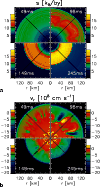 |
Figure 18:
Postshock convection in Model s15_32. Panel a) shows snapshots of
the entropy (in |
| Open with DEXTER | |
In the text
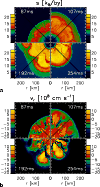 |
Figure 19:
Postshock convection in Model s112_64. Panel a) shows snapshots of
the entropy (in |
| Open with DEXTER | |
In the text
![\begin{figure}
\par\includegraphics[width=8.4cm,clip]{4654f300.eps} \end{figure}](/articles/aa/full/2006/37/aa4654-05/Timg207.gif) |
Figure 20: Mass in the gain layer with the local specific binding energy as defined in Eq. (3) (but normalized per nucleon instead of per unit of mass) above certain values. The results are shown for Models s112_32 and s112_64 for times later than 100 ms after core bounce. |
| Open with DEXTER | |
In the text
![\begin{figure}
\par\begin{tabular}{lr}
\put(0.9,0.3){{\Large\bf a}}
\includegr...
...f}}
\includegraphics[width=8.2cm]{4654f31f.eps} %
\end{tabular}\par\end{figure}](/articles/aa/full/2006/37/aa4654-05/Timg209.gif) |
Figure 21:
Postshock convection in Model s112_128_f. Panels a)-c) show
snapshots of the entropy for six post-bounce times. Panels d)-f)
display the radial velocity at the same times with maximum values of
up to 47 000 km s-1 (bright yellow). In Panel d) also the
convective activity below the neutrinosphere (at radii
|
| Open with DEXTER | |
In the text
![\begin{figure}
\par\includegraphics[width=8.4cm,clip]{4654f320.eps} \end{figure}](/articles/aa/full/2006/37/aa4654-05/Timg211.gif) |
Figure 22: Shock radii at the poles and at the equator versus post-bounce time for Model s112_128_f. |
| Open with DEXTER | |
In the text
![\begin{figure}
\par\includegraphics[width=8.4cm,clip]{4654f330.eps} \end{figure}](/articles/aa/full/2006/37/aa4654-05/Timg217.gif) |
Figure 23:
Kinetic energy, as a function of post-bounce time, associated with
the lateral velocities of the matter between
gain radius and shock (solid) and between the
|
| Open with DEXTER | |
In the text
![\begin{figure}
\par\includegraphics[width=8.4cm,clip]{4654f340.eps} \end{figure}](/articles/aa/full/2006/37/aa4654-05/Timg219.gif) |
Figure 24:
The upper panel displays the "explosion energy'' of Model s112_128_f, defined by the volume integral of the
"local specific binding energy''
|
| Open with DEXTER | |
In the text
![\begin{figure}
\par\begin{tabular}{cc}
\put(0.9,0.3){{\Large\bf a}}
\includegr...
...bf b}}
\includegraphics[width=8.5cm]{4654f35b.eps} %
\end{tabular} \end{figure}](/articles/aa/full/2006/37/aa4654-05/Timg221.gif) |
Figure 25:
Radial profiles of the specific angular momentum jz,
angular velocity |
| Open with DEXTER | |
In the text
![\begin{figure}
\par\begin{tabular}{lr}
\put(0.9,0.3){{\Large\bf a}}
\includegr...
... f}}
\includegraphics[width=8.cm]{4654f36f.eps} %
\end{tabular}\par\end{figure}](/articles/aa/full/2006/37/aa4654-05/Timg222.gif) |
Figure 26:
Snapshots of Model s15_64_r. The rotation axis is oriented
vertically. Panels a), b) show the distributions of the
specific angular momentum jz, of the angular frequency |
| Open with DEXTER | |
In the text
![\begin{figure}
\par\includegraphics[width=8.4cm,clip]{4654f370.eps} \end{figure}](/articles/aa/full/2006/37/aa4654-05/Timg228.gif) |
Figure 27:
Ratio of rotational energy to the gravitational energy,
|
| Open with DEXTER | |
In the text
![\begin{figure}
\par\includegraphics[width=8.4cm,clip]{4654f380.eps} \end{figure}](/articles/aa/full/2006/37/aa4654-05/Timg240.gif) |
Figure 28:
|
| Open with DEXTER | |
In the text
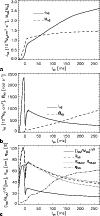 |
Figure 29:
a) Mass
|
| Open with DEXTER | |
In the text
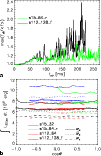 |
Figure 30:
a) Lateral maxima of the
|
| Open with DEXTER | |
In the text
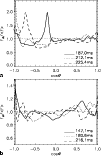 |
Figure 31:
a) Ratio of electron neutrino flux to average flux (for an
observer at rest at 400 km) versus cosine of the polar angle for
Model s112_128_f for different post-bounce times. The times are
picked such that large maxima of the flux ratio occur (see
Fig. 30a).
b) Same as panel a, but at the
|
| Open with DEXTER | |
In the text
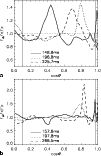 |
Figure 32:
Same as Fig. 31, but for Model s15_64_r.
The pole of the rotating model corresponds to
|
| Open with DEXTER | |
In the text
![\begin{figure}
\includegraphics[width=12cm,clip]{4654f010.eps} \end{figure}](/articles/aa/full/2006/37/aa4654-05/Timg269.gif) |
Figure A.1:
The progenitor data for temperature T, electron
fraction
|
In the text
![\begin{figure}
\includegraphics[width=12cm,clip]{4654f020.eps} \end{figure}](/articles/aa/full/2006/37/aa4654-05/Timg271.gif) |
Figure A.2:
Radial profiles of the models during core collapse
when the central density is
|
In the text
In the text
![\begin{figure}
\par\includegraphics[width=8.4cm,clip]{4654f040.eps} \end{figure}](/articles/aa/full/2006/37/aa4654-05/Timg286.gif) |
Figure B.1: Central density versus time remaining until core bounce for all 1D models. |
In the text
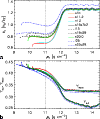 |
Figure B.2:
Central entropy (panel a)) and central electron and
lepton fraction (panel b)) versus central density during core collapse
for all 1D models. The vertical dotted line marks the time of
comparison at a central density
|
In the text
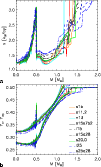 |
Figure B.3: Entropy (panel a)) and electron and lepton fraction (panel b)) versus enclosed mass at the time of shock formation. |
In the text
In the text
![\begin{figure}
\par\includegraphics[width=8.4cm,clip]{4654f100.eps} \end{figure}](/articles/aa/full/2006/37/aa4654-05/Timg322.gif) |
Figure B.5: Integrated lepton number ( top) and energy loss of the 1D models versus time. |
In the text
In the text
In the text
In the text
![\begin{figure}
\par\includegraphics[width=8.4cm,clip]{4654f12b.eps}
\end{figure}](/articles/aa/full/2006/37/aa4654-05/Timg338.gif) |
Figure E.2:
Standard deviations of the density fluctuations in lateral direction,
|
In the text
![\begin{figure}
\includegraphics[width=12cm,clip]{4654f030.eps} \end{figure}](/articles/aa/full/2006/37/aa4654-05/Timg273.gif)
![\begin{figure}
\par\includegraphics[width=16cm,clip]{4654f070.eps} \end{figure}](/articles/aa/full/2006/37/aa4654-05/Timg293.gif)
![\begin{figure}
\includegraphics[width=12cm]{4654fa10.eps} \end{figure}](/articles/aa/full/2006/37/aa4654-05/Timg324.gif)
![\begin{figure}
\begin{tabular}{c}
\put(0.9,0.3){{\Large\bf a}}
\includegraphic...
...b}}
\includegraphics[width=8.5cm]{4654fa2b.eps} %
\end{tabular}\par\end{figure}](/articles/aa/full/2006/37/aa4654-05/Timg335.gif)
![\begin{figure}
\par\includegraphics[width=8.5cm,clip]{4654f120.eps} \end{figure}](/articles/aa/full/2006/37/aa4654-05/Timg337.gif)